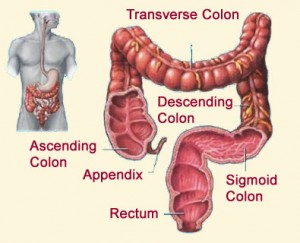This is how the AI article summary could look. Lorem ipsum dolor sit amet, consectetur adipiscing elit, sed do eiusmod tempor incididunt ut labore et dolore magna aliqua. Ut enim ad minim veniam, quis nostrud exercitation ullamco laboris nisi ut aliquip ex ea commodo consequat.
10 Colon and Rectum Anatomy Facts
Here are ten key facts about colon and rectum anatomy.

1. Definition: The colon (large intestine) is the distal part of the gastrointestinal tract, extending from the caecum to the anal canal. It receives digested food from the small intestine, from which it absorbs water and electrolytes to form faeces.
Anatomically, the colon can be divided into four parts – ascending, transverse, descending and sigmoid. These sections form an arch, which encircles the small intestine.

This diagram demonstrates where you will feel the colon and rectum.
3. Colon Structure: The colon averages 1.5m (5 foot) in length, with a diameter of 6-7 cm. Here are the four parts.
- Ascending Colon – The colon begins as the ascending colon, a retroperitoneal structure which ascends superiorly from the caecum. When it meets the right lobe of the liver, it turns 90 degrees to move horizontally. This turn is known as the right colic flexure (or hepatic flexure), and marks the start of the transverse colon.
- Transverse Colon – The transverse colon extends from the right colic flexure to the spleen, where it turns another 90 degrees to point inferiorly. This turn is known as the left colic flexure (or splenic flexure). The transverse colon is the least fixed part of the colon, and is variable in position.
- Descending Colon – After the left colic flexure, the colon moves inferiorly towards the pelvis – and is called the descending colon. It is retroperitoneal in the majority of individuals, but is located anteriorly to the left kidney, passing over its lateral border. When the colon begins to turn medially, it becomes the sigmoid colon.
- Sigmoid Colon – The 40cm long sigmoid colon is located in the left lower quadrant of the abdomen, extending from the left iliac fossa to the level of the S3 vertebra. This journey gives the sigmoid colon its characteristic ‘S’ shape.
3. Functions of the Colon and Rectum
- Absorbs water from what we drink
- Absorbs electrolytes, such as potassium and chloride, and some vitamins
- Forms and stores stool
- Moves waste out of the body.
4. Blood Supply
- Arterial: The colon’s blood supply comes from the superior mesenteric artery (supplying the right side) and inferior mesenteric artery (supplying the left side). The watershed area between these supplies is a common site for ischaemia.
- Venous: Venous drainage of the colon follows the arterial supply and drains into the hepatic portal vein, which is crucial for understanding the spread of colorectal cancer to the liver.
5. Colon Wall Layers: The colon wall consists of mucosa, submucosa, muscularis propria (inner circular and outer longitudinal layers), and serosa/adventitia. Understanding these layers is key for staging colorectal cancer.
6. Rectal Anatomy: The rectum is the lower part of the large intestine that connects to the sigmoid colon. It is about 15 cm (6 in) long. It receives waste from the colon and stores it until it passes out of the body through the anus.
7. Rectal Blood Supply: The rectum receives its blood supply from the superior rectal artery (a branch of the inferior mesenteric artery) and the middle and inferior rectal arteries (branches of the internal iliac artery).
8. Mesorectum: The mesorectum is the fatty tissue surrounding the rectum, containing lymph nodes and vessels. Total mesorectal excision (TME) is a crucial surgical principle in rectal cancer surgery to reduce local recurrence.
9. Anal Canal: The anal canal is about 3-4 cm long and extends from the anorectal junction to the anal verge. It is surrounded by the internal and external anal sphincters, crucial for continence.
10. Autonomc nerve inervation
- Sympathetic neves decrease secretomotor activity (reduces peristalsis, inhibits defecation and urination)
- Parasympathetic nerves increase secretomotor activity (promotes peristalsis, defecation and urination)
5 interesting facts about the colon and rectum
- The colon is home to trillions of microorganisms. Also known as gut flora or microbiota, these bacteria and other organisms play a vital role in digestion, breaking down material that your body cannot. This process can also produce gas, which is why passing gas is a normal bodily function.
- The average adult absorbs about one litre (one quart) of water a day via the colon. The colon’s primary job is to extract water and salt from the food waste that enters it from the small intestine. If waste moves through too quickly, less water is absorbed, causing diarrhoea. If it moves through too slowly, too much water is absorbed, causing constipation.
- The colon is the longest part of the large intestine, measuring roughly 5 feet in length. The rectum, which connects the colon to the anus, is only about 6 inches long and acts as a holding area for stool.
- You can have your colon removed and still live a healthy life. The majority of nutrient absorption occurs in the small intestine, so it is possible for people to live without a colon. This procedure, called a colectomy, may be necessary for those with inflammatory bowel disease or colon cancer.
- Some people consider one bowel movement per day to be normal. But research doesn’t support this. The frequency of bowel movements varies widely among individuals and varies widely for any single individual. The average number of times a person poops per day, reported across 39 different studies, works out to 1.1 times per day, but twice per day is within the normal range (3x a week, to 3x a day).

